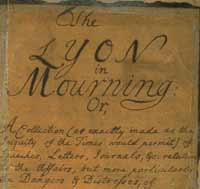Robert Forbes risked everything to capture eyewitness accounts of the Jacobite flight from Culloden. The result, part of the latest treasures display, was 'The Lyon in Mourning'. Clare Harris takes a closer look. This article appears in 'Discover NLS' issue 14.

Mourning'.
In today's age of instant technology, we can see conflict unfolding as it happens on our screens. Back in the 18th century, however, things were slower — news of defeat or victory took hours, days even, to make its way from the battleground to the public consciousness. That's what makes Robert Forbes' 'The Lyon in Mourning' so significant in both ambition and scope. —
First-hand accounts of 1745 rebellion
This historical work, on show as part of NLS Treasures display, is a collection of interviews, letters, first-hand accounts and even scraps of fabric that combine to chart the Jacobite rising and the eventual defeat and exile of its figurehead, Charles Edward Stuart. Forbes worked quickly, capturing testimonies while they remained fresh and putting them together in 'utmost secrecy'.
Born in Rayne, Aberdeenshire, the only son of a schoolmaster and a servant, Robert Forbes was baptised into the Episcopalian church in 1708. He would go on to become a minister and, in 1762, Bishop of Ross and Caithness. His was the church of the Jacobites, and as such he aligned himself with their cause — the restoration of the Stuart line to the throne. Indeed, after being prevented from taking his seat as the Bishop of Aberdeen in 1765, he assisted in secret but never realised plans for a Protestant marriage for Charles Edward, with the aim of producing an acceptable Stuart heir. Forbes had joined the Jacobite rising in 1745, only to be arrested and held in Stirling and Edinburgh Castles until May 1746, just one month after Charles Stuart's followers were defeated at the battle of Culloden. It was at that point that he began work on 'The Lyon in Mourning', the Lyon of the title signifying Scotland.
Every aspect of the Jacobite rising
While Forbes had penned other articles, translations and journals, this history would be his defining work. In it, he delved deep into every aspect of the rising, from the moment Charles Stuart landed on Scottish shores to the enduring military and political consequences. What he put to paper was as real as today's live-feed reportage. A perfectly preserved fragment of a woman's gown is tacked to the inside cover of one volume, with a note reading 'a piece of that identical gown that the Prince wore for four or five days, when he was obliged to disguise himself in a female dress under the name of Bettie Burk.'
This wonderful glimpse brings colour to the first-hand accounts inside, such as that obtained from Jacobite cavalryman Edward Burk, or Ned for short, who describes the moment he stumbled across Prince Charlie himself, 'having no right guide and very few along with him', attempting to make his way from the battlefield of Culloden to safety. There follows a now well-told story of flight through Highland glens and Hebridean sounds to the boat of one Flora MacDonald, over the sea to Skye. It was from Ned Burk, recounts Forbes, that Charles plucked the name of his female alter ego.
Started after Culloden
Working under the tightest security, Forbes produced eight manuscript volumes, each numbering more than 200 pages, within the five years following Culloden. In 1761 he started the ninth volume, followed by a 10th in 1775. This last remains unfinished, as on 18 November of the same year Forbes died in Leith. Thirteen years later came the death of Charles Stuart.
'The Lyon in Mourning' remains one of the most vivid accounts of Scottish history, precisely because it told the tale of everyone involved. Extracts were published in 1834 by Robert Chambers as 'The Jacobite Memoirs of the Rebellion of 1745', and in 1895 the full text was edited by Henry Paton and published by the Scottish History Society. It became one of the keystones of the Scottish canon, as the country moved from religious turbulence to the Enlightenment.
NLS treasures
NLS holds some of the most rare and important books, manuscripts and collections in the world. Some are so precious that they can only be displayed for short periods of time, to stop them from succumbing to decay. The Library began displaying these treasures in September 2009, allowing visitors to to see such gems as Sir Arthur Conan Doyle's manuscript of 'The Case of the Illustrious Client', bought in the summer of 2007.
The Robert Burns manuscript 'The Battle of Sherramuir', purchased at auction in the USA in January 2009, has also been on display.
'The Lyon in Mourning' will be on show at the National Library of Scotland from 20 November to 8 January, 2010. The treasures exhibition is free.
Read the full Discover NLS issue 14 (PDF: 27 pages; 1.8 MB).
